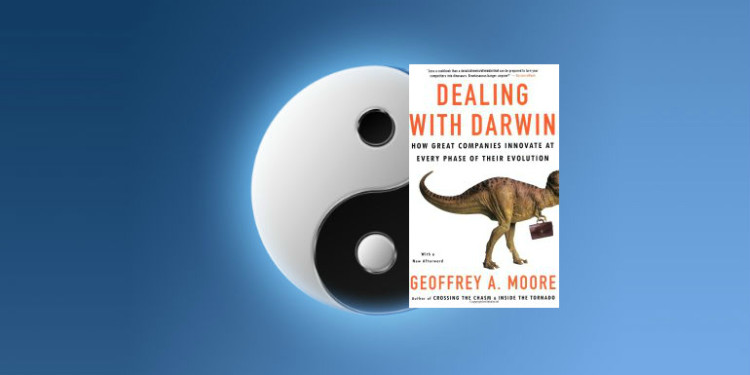Complex-systems and volume-operations businesses

Dealing with Darwin: How Great Companies Innovate at Every Phase of Their Evolution by Geoffrey Moore
Innovation strategies
Dealing with Darwin describes how various innovation strategies can be applied based on context. Geoffrey Moore argues that most effective innovation strategy will be different for different phases of market maturity (the technology adoption lifecycle) as well as enterprise type.
Two business models
He identifies two primary business architectures: complex-systems and volume-operations. Because of the differences between these two architectures, innovation methods which are successful in one will not be successful in the other. Complex-systems enterprises specialize in solving unique problems with a consulting model and custom solutions. Volume-operations, on the other hand, are focused on providing high volume markets with standard products and services.
Both models can be pushed to a breaking point: too much complexity can tax a complex-systems business and too many transactions can overwhelm a volume-operations business.
Sustainable competitive advantage is built atop one or the other of these two architectures–it is not built atop a compromise between the two.
Complex-systems
In the complex-systems model the customer is the scarce resource because there are relatively few of them. Therefore, the complex-systems business organizes itself to effectively identify, solve, and sell to individual customer needs. The entire enterprise aligns and orbits around the customer. Technology assets of the complex-system enterprise are modular and present a stable interface to customers to enable reconfiguration based on new needs.
Volume-operations
The volume-operations business has an entirely different set of concerns. Customers for the most part are not scarce–what is scarce is the ability create and present offers to the target audience. Price, availability and selection drive the offers that are made available to the customer. Producing the products and services is the priority for volume-operations businesses.
The complex-systems enterprise evolved to serve the early stage of markets during which not all assets required to build a complete solution are available and firms must take on the entire value chain to create holistic offer. This includes customer acquisition and partner selection. Once markets mature and components become readily available, volume-operations businesses enter the scene to begin optimizing products and services.
Paths to success
Success for the two models also follows different rules. For the complex-systems business, qualitative research with key customers, integration of resources around unique customer needs, and value chain management are key success factors. In the volume operations world, quantitative market research, branding, and low-touch service are the name of the game.
Moore points out that the two models move in cycles: first complex-systems enter a market to serve specific customer needs. Then, as market needs standardize, volume-operations businesses take over to create uniform offerings. This leads to complex-systems businesses moving on to the next set of unmet challenges and creating new opportunities.
Because the two enterprise types occupy different positions relative to business cycles, differentiation strategies should be considered within one or the other group, but not across both. In Moore’s view, once the strategic choice has been made between one of the two enterprise types, innovation models are then naturally chosen from within that group. Differentiation strategies are aimed at the common enterprise type, not at the opposing type.





